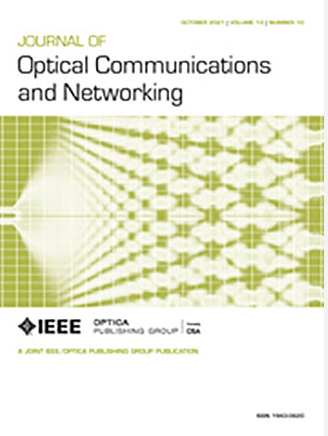光子辅助太赫兹室内光无线接入网中基于强化学习的复值空时MIMO 2D-LSTM非线性均衡器
IF 4.3
2区 计算机科学
Q1 COMPUTER SCIENCE, HARDWARE & ARCHITECTURE
引用次数: 0
摘要
光子学辅助太赫兹(THz)通信为需要高速和低延迟无线连接的室内光学无线接入网络(OWANs)提供了一种解决方案。偏振分复用(PDM)技术的应用不仅增加了系统的传输容量,而且提高了系统对室内场景物理阻塞的鲁棒性。然而,它也面临着PDM串扰和光电子器件引起的非线性损伤。提出了一种复值时空多输入多输出二维长短期记忆神经网络均衡器(ST-MIMO 2D-LSTM),可同时处理PDM中不同极化方向的信号。在前人工作的基础上,我们提出了一种基于深度确定性策略梯度算法的时空自动搜索算法(ST-ASA)的状态更新策略。通过同步更新时空参数,自动搜索神经网络均衡器的最优内部结构参数。实验演示了在290 GHz光子辅助太赫兹系统中40 GBaud PDM-QPSK信号的2米无线传输。通过使用ST-ASA自动搜索各种均衡器的最优内部结构参数,验证了新状态更新策略的有效性及其在实际应用中的优越性。随后,我们比较并验证了我们提出的ST-MIMO 2D-LSTM均衡器可以在较低的计算复杂度下获得更好的误码率(BER)性能。当进入单行载波光电二极管的光功率为0.8和2.8 dBm时,接收信号在水平和垂直极化方向的误码率分别达到${3.73}\次{{10}^{- 3}}$和${3.68}\次{{10}^{- 3}}$,低于7%的硬判决前向纠错阈值${3.8}\次{{10}^{- 3}}$,计算复杂度比1D-DNN、ST-MIMO 2D-DNN和1D-LSTM平均低26%。实验结果表明,采用新的状态更新策略的ST-MIMO 2D-LSTM均衡器与ST-ASA相结合,可以满足室内OWANs中大容量的通信需求,在支持用户移动性和促进室内机对机实现方面具有很大的潜力。本文章由计算机程序翻译,如有差异,请以英文原文为准。
Reinforcement learning-based complex-valued space-time MIMO 2D-LSTM nonlinear equalizer for photonics-assisted THz indoor optical wireless access networks
Photonics-assisted terahertz (THz) communication provides a solution for indoor optical wireless access networks (OWANs) that require high-speed and low-latency wireless connections. The application of polarization division multiplexing (PDM) technology not only increases the transmission capacity of the system but also improves its robustness to physical blockages in indoor scenes. However, it also faces PDM crosstalk and nonlinear damage caused by optoelectronic devices. This paper proposes a complex-valued space-time multiple-input multiple-output two-dimensional long short-term memory neural network (ST-MIMO 2D-LSTM) equalizer that can simultaneously process signals with different polarization directions of the PDM. On the basis of our previous work, we propose a new, to the best of our knowledge, state update strategy for the space-time automatic search algorithm (ST-ASA) based on the deep deterministic policy gradient algorithm. By simultaneously updating the space-time parameters, the optimal internal structural parameters of the neural network equalizer are automatically searched. The experiment demonstrated the 2 m wireless transmission of a 40 GBaud PDM-QPSK signal in a 290 GHz photonics-assisted THz system. By using ST-ASA to automatically search for the optimal internal structural parameters of various equalizers, we verify the effectiveness of the new state update strategy and its superiority in practical applications. Subsequently, we compare and verify that our proposed ST-MIMO 2D-LSTM equalizer can achieve better bit error rate (BER) performance with lower computational complexity. When the optical power into the uni-traveling-carrier photodiode is 0.8 and 2.8 dBm, the BER of the received signals in the horizontal and vertical polarization directions can reach ${3.73} \times {{10}^{- 3}}$ and ${3.68} \times {{10}^{- 3}}$ , respectively, which are lower than the 7% hard decision forward error correction threshold of ${3.8} \times {{10}^{- 3}}$ , and the computational complexity is on average 26% lower than 1D-DNN, ST-MIMO 2D-DNN, and 1D-LSTM. The experimental results show that the ST-MIMO 2D-LSTM equalizer combined with ST-ASA using the new state update strategy can meet the communication requirements of a large capacity in indoor OWANs and has great potential in supporting user mobility and promoting the implementation of indoor machine to machine.
求助全文
通过发布文献求助,成功后即可免费获取论文全文。
去求助
来源期刊
CiteScore
9.40
自引率
16.00%
发文量
104
审稿时长
4 months
期刊介绍:
The scope of the Journal includes advances in the state-of-the-art of optical networking science, technology, and engineering. Both theoretical contributions (including new techniques, concepts, analyses, and economic studies) and practical contributions (including optical networking experiments, prototypes, and new applications) are encouraged. Subareas of interest include the architecture and design of optical networks, optical network survivability and security, software-defined optical networking, elastic optical networks, data and control plane advances, network management related innovation, and optical access networks. Enabling technologies and their applications are suitable topics only if the results are shown to directly impact optical networking beyond simple point-to-point networks.

 求助内容:
求助内容: 应助结果提醒方式:
应助结果提醒方式:


